The Product Launch Funnel That Generated $2k Within 2 Weeks With $0 Ad Spend

By DAWN-MARIE NESBITT
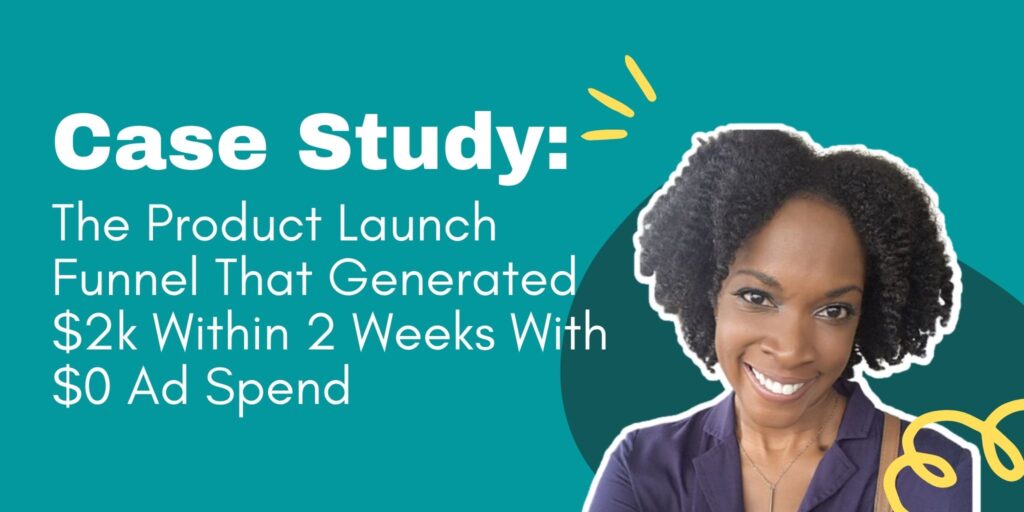
In this case study, I am going to show you, the strategy that I used, to sell one of my digital products, without spending any money on ads.
Many people feel that you need to spend money on Facebook Ads to sell a product that they’re launching. Of course Facebook Ads can help you get more eyes on your offer. But if you’re not yet ready to invest in Facebook Ads, here is a strategy that you can use to sell your products with organic traffic.
Before I go into this case study, I want to preface this by saying, you must have a way to get people to see your offer. If you do not, you won’t be successful in launching any product.
The reason why this launch was successful, was because I had a huge traffic source from my blog; a blog which I built from the ground up and learnt how to get traffic to it using Pinterest.
This case study is useful if:
- You want to sell your own courses or workshops
- You want to learn how to sell your products or offers online
- You want to sell your online courses but don’t know where to start
- You want to sell your online or offline workshops but don’t know where to start
- You have launched your own course or workshop but got poor results
The Product And Why I Created It
The product was a Masterclass that taught my students how to Build a Blog as a Business. It was packaged into an ebook and a prelude to my high-ticket coaching program.
I got the inspiration to create this product, because most of my blog visitors asked for coaching on how to start a blogging career.
Key Takeaway:
Before you create your course or launch a workshop, make sure that you validate it and prove that there is a need for it. You can do research first, to see if there is a need, by forming a research group or asking your target audience what their problems are.
My Strategy In A Nutshell
To bring attention to my launch, I first placed a notification bar at the top of my blog using the plugin WP Notification Bars.
This ensured that anyone who visited my blog, would be aware that I was creating this offer and they could express an interest in it, by clicking on the link that took them to my sales funnel.
I created two sales funnels for this launch. One sales funnel had a long landing page and the other sales funnel had a short landing page.
The reason why I created two sales funnels with long and short pages is because it is important to test variations in your marketing strategy, to see which one converts better and gives you the best results. I designed my funnel using a sales funnel builder called LeadPages. If you’d like to try this tool, you can get a 14-day free trial here.
The purpose of these sales funnels, is to generate leads so that they can become a part of my
intimate subscriber base, where I tell them more about my offer. With a sales funnel, it was a way to build the relationship with my audience, as well as have their undivided attention in their inbox, so I can pre-sell them on the Masterclass and warm them up for the sale.
Key Takeaway:
Whilst it is a good strategy, to sell your offer directly from a sales page, it is not the best strategy. Why do I say so? Well when you sell a product from a sales page, you do not know who has visited the page and there is no way to capture their data to follow up with them, if you're not tracking them with a pixel or you have no intention of re-targeting them with paid advertising.
Not everyone who has visited a sales page is going to buy right now. You have to convince them that the product is worth their investment.
When you sell a product from an email list, however, not only have you captured their data, but you can pre-sell them on the benefits of the product, making them more likely to buy, plus you can now transform the lead from a cold one to a warm one, by providing immense value, making them more likely to trust your expertise.
When someone trusts your expertise in this way, you can sell them anything!
Also, by being on an email list, you can really demonstrate your value. You really want to offer help, so they don’t see you as someone who just wants the sale.
When you build anything online, remember, you have to be there for the person not just before the sale, but after and being able to communicate with that list is paramount to you getting repeat sales.
After The Opt In
Once people opted in, by providing their name and email address, they moved on to my thank you page.
The thank you page, is also created by LeadPages.
On the thank you page, pay attention to the 2 main elements of the page.
The first element being the actual message that I gave to the lead. I gave very specific instructions as to what they should do after opting in.
Key Takeaway:
Some marketers feel that people will automatically know what to do, when they take an action. To get people to take action, you have to tell them to take the specific action. Therefore, when you want something done by your audience, literally spell it out for them.
Here’s what I said on my thank you page:
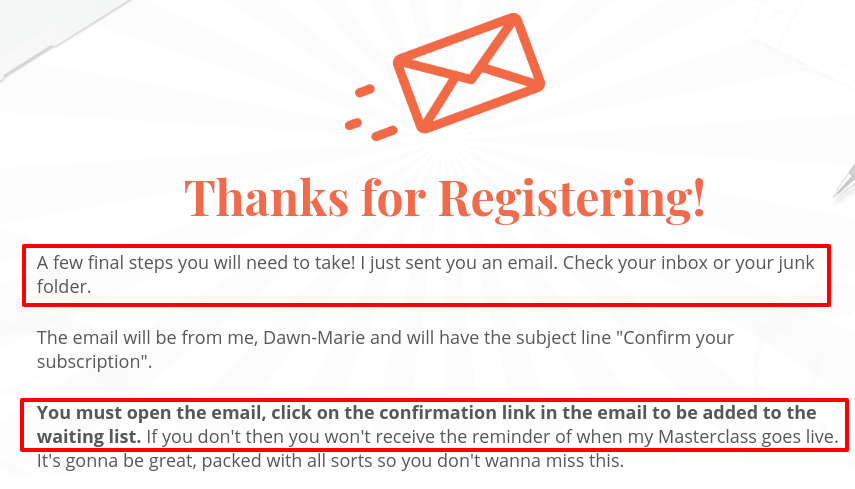
I told my leads to check their inbox or junk mail for a confirmation email. I also told them to open the email, click on the confirmation link so they could be added to the waiting list. Do you see how specific I was?
The Email Series
Once people were on my email list, they were sent 5 pre-written, automated emails spread across 10 days, all providing helpful content to warm them up for the sale.
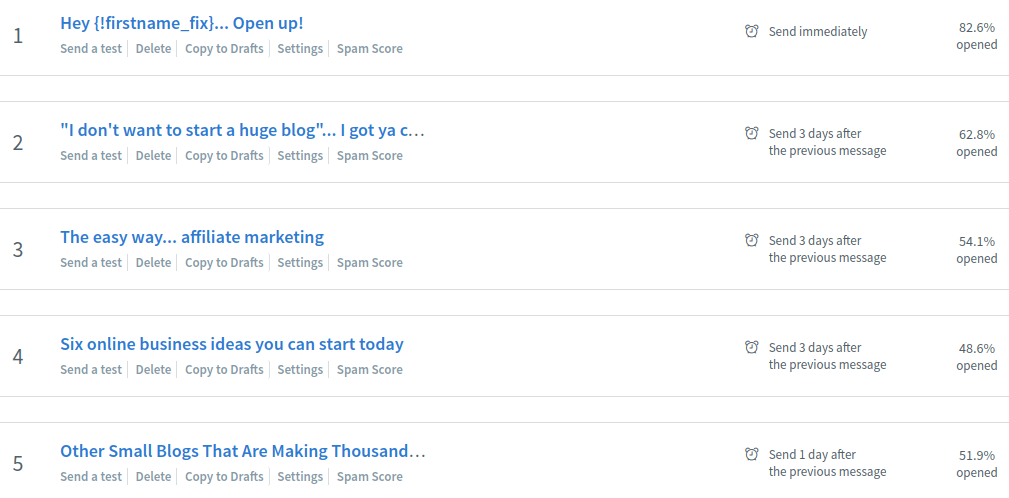
When creating your email series, think about what your audience wants to learn from you.
What are their pain points? Can you address this in an email?
Can you provide any tips to demonstrate expertise?
Feel free to get personal. It doesn’t have to be all about business. Tell them a relatable story so they can really know not only the business side of you, but also what goes on, in your daily life.
Remember that the subscribers on your email list are cold. They know nothing about you, and it is up to you, to talk to them in a way, that shows you know what you’re talking about and also that you’re ready to help them.
Here is what one email looks like:
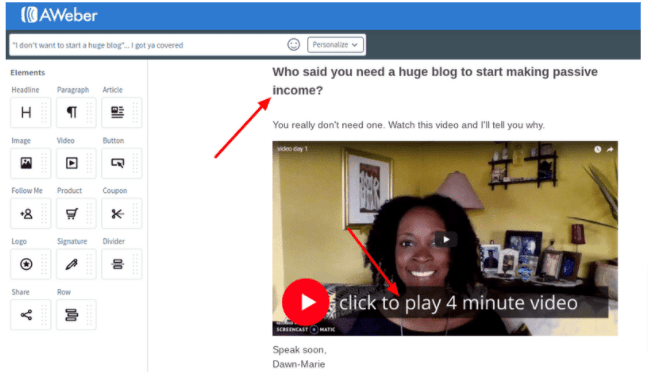
Typically my emails are all written, but this time for this launch and to build the relationship quicker, I decided to create videos sharing useful information as a way for the viewer to see who they are entering business with and also to help them trust me.
True story: I had an interesting subscriber email me one day and tell me, that usually she can spell BS just by looking at the eyes of the person. This got me thinking and made me really step out of my comfort zone to create these videos, so I can reveal that I can be trusted.
There are two things, I want you to pay attention to in this email
- Notice my headline. I open with a question – “who said you need a huge blog to start making passive income?” I know that my audience wants to solve this major headache and myth that they are told, that they need to create a huge blog to make money from it. This is their pain point and my product would finally solve that problem.
- Notice how short my video is. I purposely put the length of the video so that I could get my leads to commit to watching the video. The longer the video, the less commitment you will get. I wanted clicks, so by asking my subscribers to commit, just 4 short minutes to watching my video, I knew that I would get clicks to it.
The Email and The Tools Used
To send the automated emails, I used Aweber.
Aweber is an email marketing software that helps you send mass emails to your subscribers. You can try this software for 30 days by getting your free 30-day trial here.
The Pre-Sell Schedule
Here is what my pre-sell schedule looked like:
March 01st sales funnel launched to generate leads
April 12th FAQ email
April 13th My story and another introduction to me
April 14th Open cart email
April 16th Reminder email
April 17th Last chance email
Remember that my pre-sell schedule not only included the above emails, but also the 5 automated, pre-written emails that I set up in my email autoresponder to send automatically.
So by the time that people received these broadcast messages, they had some content from me which was designed to warm them up and keep them engaged, most important!
My email list was less than 200 for this launch.
I say this to say, you do not need a huge email list or audience to sell your courses or workshops. You only need a targeted and engaged email list.
Next I will break down really quickly, what my pre-sell schedule emails looked like.
April 12th FAQ email I made sure to answer any questions that people may have about the Masterclass.
April 13th My story and introduction email In this email, I kept it real. I told my story about how I started blogging and the reason why I wanted to start a blog.
I made sure that my email was totally relatable and I played on the emotions of my subscribers by highlighting their pain points through my experiences.
April 14th Open cart email This email, I told my subscribers that the Masterclass was going live and ready for purchase. This is where I got to get “on stage” and make my huge pitch.
April 16th Reminder email The reminder email was a reminder that I launched my Masterclass.
This email was for those people, who probably did not get the first email the day before.
I also included a testimonial in this email, just to show that people work with me and trust me.
Then I included this one tactic, that made sure that sales continued, and that was a tactic to create urgency, so people would buy now, instead of leaving it for later.
That tactic was letting my subscribers know that the price was going up!
If you could buy a product at a lower price, would you not buy it now, rather than later at a higher price?
April 17th Last Chance email This email, was where I told my subscribers, they only had a few more hours to get into my Masterclass, before my price went up.
If they did not buy, I would increase it to $47.
Some marketers do not hold true to their word, so don’t act like you’re bluffing. Make sure that if you say you’re going to increase your price, that you do increase it.
Even after I increased my price, I still got sales!
The Results
To show you just how effective this overall strategy can be, these were the type of results that I got.
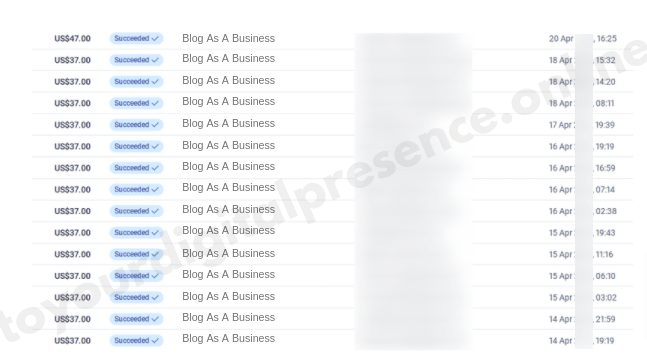
Once my students purchased and joined the Masterclass, I now had a buyer’s email list, to which I could promote my high-ticket coaching program.
After Thoughts
I was really happy with this launch.
With just a few emails, promoting on an almost-forgotten search engine such as Pinterest and just four days after going live, I was able to sell my new Masterclass.
It is worth mentioning that after those four days, I still continued to get sales at the increased price of $47, so if you are ever worried about whether your increased price will hurt you, my answer is no.
Key Takeaway:
When you are preparing for the launch of your course or workshop, share what the buyer is likely to expect, ease their concerns and just overall help them to achieve success.
This is a typical strategy that I use to launch my offers.
All you need is a good offer, a quality traffic source and a good strategy.
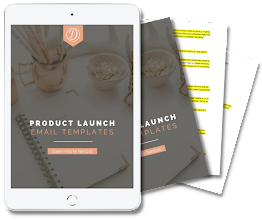
Product Launch Email Templates
My 10-Day Welcome Series Fill-In-The-Blanks Email Templates (that made me approx $2k in 2 wks). When you get a subscriber, what happens next? With my fill-in-the-blanks welcome series templates, build trust and immediately establish credibility with these templates that were specifically designed to turn strangers into eager subscribers who are ready to buy my low-ticket offer.